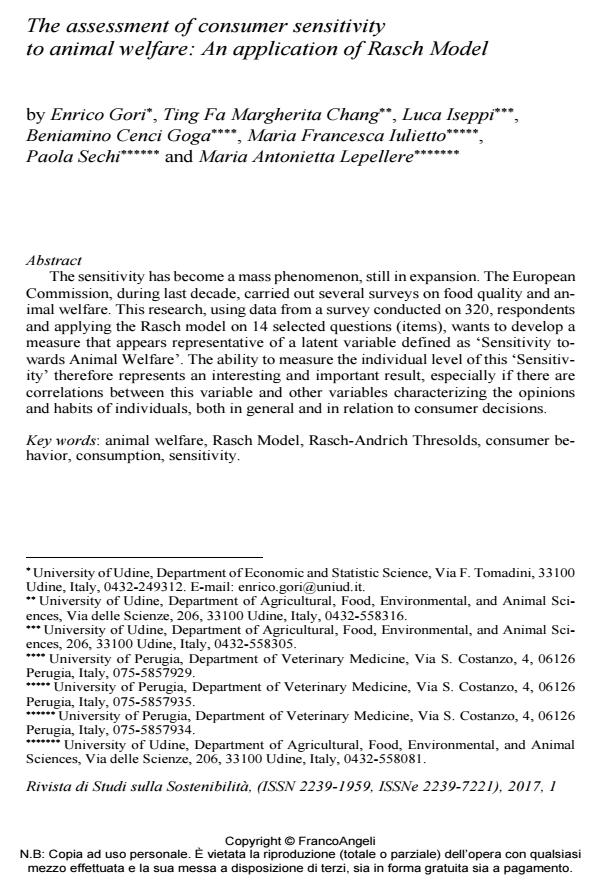The assessment of consumer sensitivity to animal welfare: An application of Rasch Model
Titolo Rivista RIVISTA DI STUDI SULLA SOSTENIBILITA'
Autori/Curatori Enrico Gori, Ting Fa Margherita Chang, Luca Iseppi, Beniamino Cenci Goga, Maria Francesca Iulietto, Paola Sechi, Maria Antonietta Lepellere
Anno di pubblicazione 2017 Fascicolo 2017/1
Lingua Inglese Numero pagine 21 P. 107-127 Dimensione file 275 KB
DOI 10.3280/RISS2017-001008
Il DOI è il codice a barre della proprietà intellettuale: per saperne di più
clicca qui
Qui sotto puoi vedere in anteprima la prima pagina di questo articolo.
Se questo articolo ti interessa, lo puoi acquistare (e scaricare in formato pdf) seguendo le facili indicazioni per acquistare il download credit. Acquista Download Credits per scaricare questo Articolo in formato PDF

FrancoAngeli è membro della Publishers International Linking Association, Inc (PILA)associazione indipendente e non profit per facilitare (attraverso i servizi tecnologici implementati da CrossRef.org) l’accesso degli studiosi ai contenuti digitali nelle pubblicazioni professionali e scientifiche
The sensitivity has become a mass phenomenon, still in expansion. The Euro-pean Commission, during last decade, carried out several surveys on food quality and animal welfare. This research, using data from a survey conducted on 320, respondents and applying the Rasch model on 14 selected questions (items), wants to develop a measure that appears representative of a latent variable defined as ‘Sensitivity towards Animal Welfare’. The ability to measure the individual level of this ‘Sensitivity’ therefore represents an interesting and important result, especially if there are correlations between this variable and other variables characterizing the opinions and habits of individuals, both in general and in relation to consumer decisions.
La sensibilità nei confronti degli animali è diventata un fenomeno di massa, in continua espansione. La Commissione europea, nel corso dell’ultimo decennio, ha svolto diverse indagini sulla qualità degli alimenti e sul benessere degli animali. Questa ricerca, utilizzando i dati di un sondaggio condotto su 320 soggetti e applicando il modello di Rasch su 14 domande selezionate, vuole sviluppare una misura che sia rappresentativa di una variabile latente definita come "Sensibilità verso il benessere degli animali". La possibilità di misurare a livello individuale questa "sensibilità" rappresenta quindi un risultato interessante e importante, soprattutto se ci sono correlazioni tra questa variabile e altre variabili che caratterizzano le opinioni e le abitudini degli individui, sia in generale che in relazione alle decisioni dei consumatori.
Parole chiave:Benessere animale, Modello di Rasch, Soglie di Rasch-Andrich, comportamento del consumatore, sensibilità.
- THE HIDDEN TURNING POINTS OF THE MEDITERRANEAN DIET: A TOOL FOR HEALTH AND AGRO-FOOD POLICIES. RATING OUT OF FIFTY YEARS, AND 22 COUNTRIES Maria Antonietta Lepellere, Ting Fa Margherita Chang, Maurizio Droli, Luca Iseppi, in New Medit /2019 pp.71
DOI: 10.30682/nm1902e - A formal model for assessing the economic impact of animal welfare
improvements at bovine and porcine slaughter J Jerlström, C Berg, AH Karlsson, A Wallenbeck, H Hansson, in Animal Welfare /2022 pp.361
DOI: 10.7120/09627286.31.4.004
Enrico Gori, Ting Fa Margherita Chang, Luca Iseppi, Beniamino Cenci Goga, Maria Francesca Iulietto, Paola Sechi, Maria Antonietta Lepellere, The assessment of consumer sensitivity to animal welfare: An application of Rasch Model in "RIVISTA DI STUDI SULLA SOSTENIBILITA'" 1/2017, pp 107-127, DOI: 10.3280/RISS2017-001008